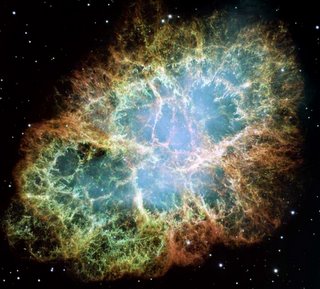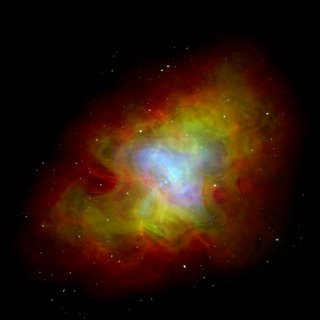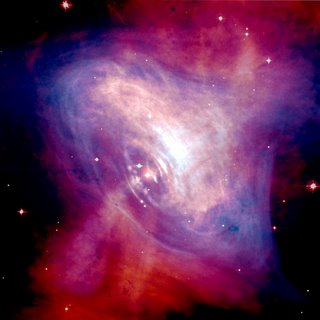
The Crab Nebula is cataloged as M1, the first object on Charles Messier's famous list of things which are not comets. In fact, the cosmic Crab is now known to be a supernova remnant, an expanding cloud of debris from the death explosion of a massive star. Light from that stellar catastrophe was first witnessed by astronomers on planet Earth in the year 1054. Composed of 24 exposures taken in October 1999, January 2000, and December 2000, this Hubble Space Telescope mosaic spans about twelve light years. Colors in the intricate filaments trace the light emitted from atoms of hydrogen, oxygen, and sulfur in the debris cloud. The spooky blue interior glow is emitted by high-energy electrons accelerated by the Crab's central pulsar. One of the most exotic objects known to modern astronomers, the pulsar is a neutron star, the spinning remnant of the collapsed stellar core. The Crab Nebula lies about 6,500 light-years away in the constellation Taurus.

This is the mess that is left when a star explodes. The Crab Nebula, the result of a supernova seen in 1054 AD, is filled with mysterious filaments. The filaments are not only tremendously complex, but appear to have less mass than expelled in the original supernova and a higher speed than expected from a free explosion. The above image, taken by the Nordic Optical Telescope (NOT), is in three colors chosen for scientific interest. The Crab Nebula spans about 10 light-years. In the nebula's very center lies a pulsar: a neutron star as massive as the Sun but with only the size of a small town. The Crab Pulsar rotates about 30 times each second.

The Crab Pulsar, a city-sized, magnetized neutron star spinning 30 times a second, lies at the center of this composite image of the inner region of the well-known Crab Nebula. The spectacular picture combines optical data (red) from the Hubble Space Telescope and x-ray images (blue) from the Chandra Observatory, also used in the popular Crab Pulsar movies. Like a cosmic dynamo the pulsar powers the x-ray and optical emission from the nebula, accelerating charged particles and producing the eerie, glowing x-ray jets. Ring-like structures are x-ray emitting regions where the high energy particles slam into the nebular material. The innermost ring is about a light-year across. With more mass than the Sun and the density of an atomic nucleus, the spinning pulsar is the collapsed core of a massive star that exploded, while the nebula is the expanding remnant of the star's outer layers. The supernova explosion was witnessed in the year 1054.
 The Crab Nebula is cataloged as M1, the first object on Charles Messier's famous list of things which are not comets. In fact, the cosmic Crab is now known to be a supernova remnant, an expanding cloud of debris from the death explosion of a massive star. Light from that stellar catastrophe was first witnessed by astronomers on planet Earth in the year 1054. Composed of 24 exposures taken in October 1999, January 2000, and December 2000, this Hubble Space Telescope mosaic spans about twelve light years. Colors in the intricate filaments trace the light emitted from atoms of hydrogen, oxygen, and sulfur in the debris cloud. The spooky blue interior glow is emitted by high-energy electrons accelerated by the Crab's central pulsar. One of the most exotic objects known to modern astronomers, the pulsar is a neutron star, the spinning remnant of the collapsed stellar core. The Crab Nebula lies about 6,500 light-years away in the constellation Taurus.
The Crab Nebula is cataloged as M1, the first object on Charles Messier's famous list of things which are not comets. In fact, the cosmic Crab is now known to be a supernova remnant, an expanding cloud of debris from the death explosion of a massive star. Light from that stellar catastrophe was first witnessed by astronomers on planet Earth in the year 1054. Composed of 24 exposures taken in October 1999, January 2000, and December 2000, this Hubble Space Telescope mosaic spans about twelve light years. Colors in the intricate filaments trace the light emitted from atoms of hydrogen, oxygen, and sulfur in the debris cloud. The spooky blue interior glow is emitted by high-energy electrons accelerated by the Crab's central pulsar. One of the most exotic objects known to modern astronomers, the pulsar is a neutron star, the spinning remnant of the collapsed stellar core. The Crab Nebula lies about 6,500 light-years away in the constellation Taurus. This is the mess that is left when a star explodes. The Crab Nebula, the result of a supernova seen in 1054 AD, is filled with mysterious filaments. The filaments are not only tremendously complex, but appear to have less mass than expelled in the original supernova and a higher speed than expected from a free explosion. The above image, taken by the Nordic Optical Telescope (NOT), is in three colors chosen for scientific interest. The Crab Nebula spans about 10 light-years. In the nebula's very center lies a pulsar: a neutron star as massive as the Sun but with only the size of a small town. The Crab Pulsar rotates about 30 times each second.
This is the mess that is left when a star explodes. The Crab Nebula, the result of a supernova seen in 1054 AD, is filled with mysterious filaments. The filaments are not only tremendously complex, but appear to have less mass than expelled in the original supernova and a higher speed than expected from a free explosion. The above image, taken by the Nordic Optical Telescope (NOT), is in three colors chosen for scientific interest. The Crab Nebula spans about 10 light-years. In the nebula's very center lies a pulsar: a neutron star as massive as the Sun but with only the size of a small town. The Crab Pulsar rotates about 30 times each second. The Crab Pulsar, a city-sized, magnetized neutron star spinning 30 times a second, lies at the center of this composite image of the inner region of the well-known Crab Nebula. The spectacular picture combines optical data (red) from the Hubble Space Telescope and x-ray images (blue) from the Chandra Observatory, also used in the popular Crab Pulsar movies. Like a cosmic dynamo the pulsar powers the x-ray and optical emission from the nebula, accelerating charged particles and producing the eerie, glowing x-ray jets. Ring-like structures are x-ray emitting regions where the high energy particles slam into the nebular material. The innermost ring is about a light-year across. With more mass than the Sun and the density of an atomic nucleus, the spinning pulsar is the collapsed core of a massive star that exploded, while the nebula is the expanding remnant of the star's outer layers. The supernova explosion was witnessed in the year 1054.
The Crab Pulsar, a city-sized, magnetized neutron star spinning 30 times a second, lies at the center of this composite image of the inner region of the well-known Crab Nebula. The spectacular picture combines optical data (red) from the Hubble Space Telescope and x-ray images (blue) from the Chandra Observatory, also used in the popular Crab Pulsar movies. Like a cosmic dynamo the pulsar powers the x-ray and optical emission from the nebula, accelerating charged particles and producing the eerie, glowing x-ray jets. Ring-like structures are x-ray emitting regions where the high energy particles slam into the nebular material. The innermost ring is about a light-year across. With more mass than the Sun and the density of an atomic nucleus, the spinning pulsar is the collapsed core of a massive star that exploded, while the nebula is the expanding remnant of the star's outer layers. The supernova explosion was witnessed in the year 1054.








0 Comments:
Post a Comment
<< Home